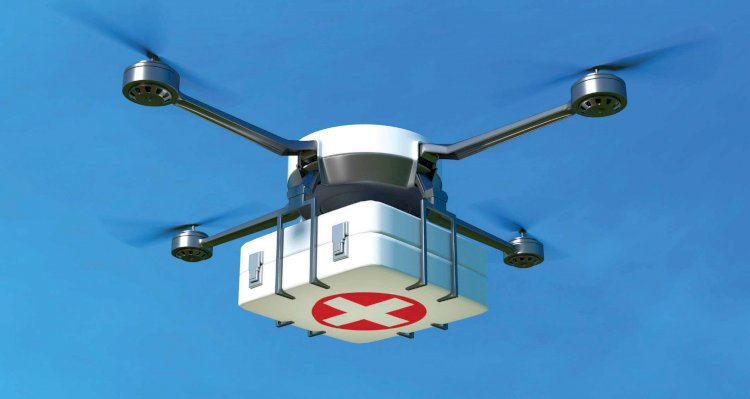United States Medical Drone Market to Grow at a CAGR of 23.1% during Forecast Period
A recent study by the strategic consulting and market research firm, BlueWeave Consulting, revealed that the United States medical drone market is projected to grow at a CAGR of 23.1% during the forecast period.

A recent study by the strategic consulting and market research firm, BlueWeave Consulting, revealed that the United States medical drone market is projected to grow at a CAGR of 23.1% during the forecast period. The United States Medical Drone market is booming because of the rising government reimbursement policies. The United States' robust economic standing and the availability of a highly established healthcare infrastructure are driving the market's expansion. The need for high-quality healthcare services is growing due to the nation's rising GDP and per capita income. However, the high cost of maintaining drones and the regulation imposed by the government act as a restraining factors for the market growth.
Favorable Government Reimbursement Policies
Favorable government reimbursement policies encourage high-quality medical treatment and make it more affordable for patients, fueling industry expansion. The development of medical drones benefits from a variety of government funding sources as well as support from private companies. For example, stepping up government efforts to create unarmed aircraft will encourage innovation. Additionally, Zipline is involved in distributing vaccines, life-saving drugs, and blood. The government's primary objective in launching these projects is to save lives by making medicines available when required.
Increasing Demand For Quality Healthcare Services
The United States' robust economic standing and the availability of a highly established healthcare infrastructure are driving the market's expansion of medical drones in the United States. The need for high-quality healthcare services is growing due to the nation's rising GDP and per capita income. As a result, not only citizens of the country but also healthcare professionals are prioritizing quality healthcare service in the country. Drone use offers a possibility to improve healthcare, particularly in remote or underserved areas, by enabling just-in-time delivery of essential medical supplies and devices, speeding up lab testing turnaround times, and lowering the cost of regular prescription care in rural locations.
Request for Sample Report @ https://www.blueweaveconsulting.com/report/united-states-medical-drone-market/report-sample
High Cost For Maintaining The Drones And The Regulation Imposed By Government Act As A Restraining Factor For The Market Growth
The strict government rules are one factor that may somewhat impede industry expansion, and the deployment procedure is becoming a little more challenging due to these limitations. Last but not least, the cost of operation and maintenance associated with various drone types may also be a factor that hinders the overall expansion of the medical drone market. However, with so much research and development being done, we can anticipate the best services in the near future at a lower cost. Additionally, one of the primary driving forces is the growing government participation, which will aid in surpassing the medical drone market's restraint.
The Blood Transfer Segment Is Anticipated To Remain Dominant In The Market During The Forecast Period
By application, the market is segmented into blood transfer, drugs/pharmaceutical transfer, vaccination programs, and others. The market's dominating category has generally been blood transfer, and this trend is expected to continue during the projection period. This market's rise can be attributed to the rising demand and adoption of unmanned system logistics for supplying pathological blood products and blood samples. The logistics for vaccines is the market sector that is growing most quickly. During the forecast period, it rises due to the high demand for immunizations against various illnesses, epidemics, viral outbreaks, and the ongoing COVID-19 pandemic. One reason for the development is the capability of medical drones to deliver vaccinations quickly to far-off regions. Additionally, many agencies, like UNICEF, fund medical drones to deliver vaccines in remote areas and during emergencies, fostering market growth.
Impact of COVID-19 on United States Medical Drone Market
During the pandemic, several businesses ran drone delivery trials in the U.S., frequently using specialized, strictly regulated permissions for flight outside the visual line of sight provided by the Federal Aviation Administration. The use of drones by government organizations has increased due to their deployment for non-intrusive public monitoring and surveillance applications. Through their monitoring and surveillance, these organizations have improved their situational awareness and helped the public follow pandemic rules in various ways. Additionally, several academic institutions have been tracking the symptoms within the populace utilizing drone monitoring powered by artificial intelligence and infrared photography.
Competitive Landscape
Key players operating in the United States Medical Drone market are Zipline International Inc.(U.S.), Volansi, Inc. (U.S.), Flirtey(U.S.), Matternet(U.S.), Vayu Inc. (Ypsilanti U.S.), VillageReach, Alphabet, Inc. (Google Drones), The Boeing Company, DJI United States, Alpine 4 Holdings Inc., Draganfly, Inc., Skydio Inc., and other prominent players. Various strategies such as investment in R&D, new business ventures, production facilities, production capabilities, and product launches are used by market players to stay competitive.
Contact Us:
BlueWeave Research Blog
Phone No: +1 866 658 6826
Email: info@blueweaveconsulting.com




























